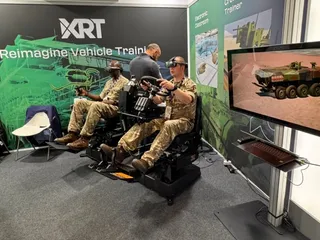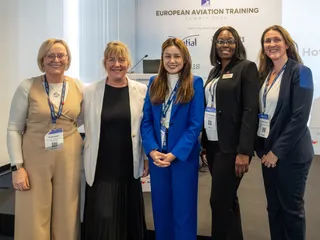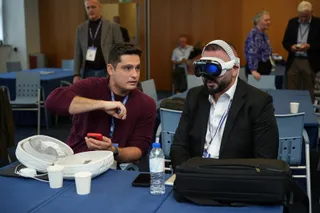Cabin Crew Training Market Disruptor
Contact Our Team
For more information about how Halldale can add value to your marketing and promotional campaigns or to discuss event exhibitor and sponsorship opportunities, contact our team to find out more
The Americas -
holly.foster@halldale.com
Rest of World -
jeremy@halldale.com

This 6 February Group Editor Marty Kauchak completed a wide-ranging interview with Marc Van Den Broucque, Managing Director, Spatial. The content from the interview follows.
CAT: Marc, we last spoke at EATS 2024. For our followers who have not had a similar, recent opportunity to engage with you, update us on recent developments at Spatial through 2024 and a summary of where we will find Spatial cabin crew training devices in the global commercial aviation community.
Marc Van Den Broucque (MVDB): 2024 was another successful year for Spatial. We started the year by expanding our manufacturing facility to add over 65% additional area for production allowing us to successfully deliver the strong order book we had in place. This came online in March 2024 and has been well used since. We were proud to continue serving many of our existing long-term clients such as Qantas and United, whilst welcoming a number of new airline customers to our products, such as Qatar Airways and Riyadh Air. With a team of over 275 employees now, we are the largest player in the cabin crew market and are more than double the size of the next largest manufacturer of cabin training equipment.
CAT: About one year ago we learned of a runway collision involving one operating JAL 350-900 aircraft (JAL516). How are that event and other evolving regulatory agency and airline customer requirements shaping your training device portfolio?
MVDB: That incident in particular demonstrated the importance of effective evacuation procedures in preventing further loss of life. The evacuation procedures themselves have not changed significantly, but what has is the focus on human factors and evacuation efficiency. For instance, in the JAL case the fact that there were clear safety briefings leading to passengers behaving almost exactly as instructed meant the evacuation was far more efficient than most industry participants would expect in these circumstances. A number of our airline customers have since looked at the learnings from this incident and implemented initiatives such as no-nonsense safety briefings.
CAT: One tenet of your product life cycle focus is increased realism. Tell us how Spatial is expanding realism to support the expectations of Gen Z and other increasingly younger training audiences and at the same time meeting community regulations and customer requirements.
MVDB: Whether Gen Z or other generations, it has always been the case that people learn best by doing – they want to be immersed in an environment, experience it first-hand and live through the emotions of the situation. That is
ultimately what helps commit learnings to memory. We have been making devices with enhanced realism such as motion systems, paired visuals, fire and smoke simulations for some time, so there is nothing new there per-se, but we have been continuously improving the quality of our offering. We are also seeing as a general trend that more people are adopting these technologies as a standard component of our device than before. Whereas in the past features such as visual simulations were a nice-to-have, they are now rarely seen as an option, but as a necessity to deliver effective training.
CAT: Our first follow-up: tell us some of Spatial’s simulation and training industry partners that help you deliver increased realism and other capabilities for your products.
MVDB: At Spatial, we tend to develop most of our technologies in-house as we like to have as much control as possible over the quality of the end product and have the ability to customize them to individual clients’ needs. There are two exceptions to this. For motion systems where we work with both Van Halteren and E2M to deliver 3-axis and 6-axis depending upon the specific requirements of our customers. We have also recently entered into an exclusive partnership with Freestyle Slides, a company with a 20(+)-year track record leading the inflatables market to produce high quality evacuation training slides and rafts for our customers.
CAT: A “macro-level” question: how, if at all, has the slower pace of commercial aircraft deliveries from Airbus and Boeing during the latter part of 2024 impacted the “demand signal” for your products and perhaps even had a ripple effect on your supply chain?
MVDB: Cabin crew trainers offer higher scalability than pilot trainers. Whereas in the cockpit you can only have two seats filled at a time, in the cabin you can train 20 or 30 people simultaneously with ease. What that means is we have a less direct correlation between aircraft deliveries and the need for training equipment. Purchases of our devices tend to be driven more by the introduction of new aircraft types or need for replacement devices rather than pure capacity needs. As such, we have been less affected by the slower pace of aircraft deliveries, although the one exception to this would be the B777-9, where in spite of delivering the first CEET for this aircraft type globally a few years ago there has been a delay in other future customers placing orders for training equipment due to continued uncertainty surrounding the entry into service of this new aircraft.
CAT: And another follow-up: your projection of the economic health and stability of the 2025 global commercial aviation industry as it impacts Spatial and other S&T industry companies.
MVDB: Due to the customized nature of our devices and the lead times involved, we have good insights into how this year will look, and it will be another healthy one for Spatial. For us, the key question is what will happen in 2026. The economic landscape is less predictable than it has been in recent years, with threats of trade wars, persistently higher than expected inflation, geopolitical risks and other factors hanging over our heads. How this will evolve is anyone’s guess at the moment, but our focus will be on keeping our focus on delivering excellent training devices for our customers. If our customers are well looked after, we will put ourselves in the best position we can in spite of any
economic headwinds.
CAT: A preview of key milestones on Spatial’s 2025 roadmap – perhaps, product upgrades, scheduled training product deliveries and such.
MVDB: 2024 was a good year for Spatial in terms of R&D, with new products in the A220 family, Embraer E2 family, B737 mid-cabin exits and A320 Airspace interiors keeping us busy as well as some bespoke products such as remote-controlled synthetic improvised explosive devices being developed for the first time. For 2025, we have a couple of new initiatives – upgrading our motion system integrations with both Van Halteren and E2M continuous improvements around customer support infrastructure, and a top-secret project in our Spatial Skunk Works team that we hope will take levels of realism to even higher levels still.
CAT: Thank you for your time and we look forward to again meeting with you at WATS 2025.
MVDB: Our pleasure as always, and we look forward especially to seeing you at the Cabin Crew stream, which Spatial will be proudly sponsoring this year.


